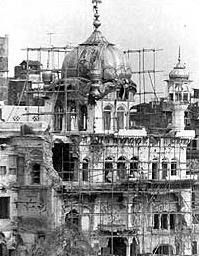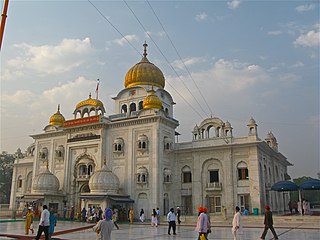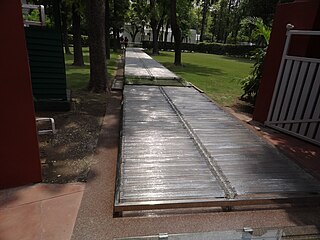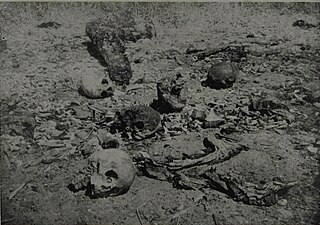
Operation Blue Star was a military operation by the Indian Armed Forces conducted between 1 and 10 June 1984 to remove Jarnail Singh Bhindranwale and other Sikh militants from the Golden Temple, a holy site of Sikhism, and its adjacent buildings.

Amritsar, historically also known as Rāmdāspur and colloquially as Ambarsar, is the second-largest city in the Indian state of Punjab, after Ludhiana. Located in the Majha region, it is a major cultural, transportation and economic centre. The city is the administrative headquarters of the Amritsar district. It is situated 217 km (135 mi) north-west of Chandigarh, and 455 km (283 mi) north-west of New Delhi. It is 28 km (17.4 mi) from the India-Pakistan border, and 47 km (29 mi) north-east of Lahore, Pakistan.

Gurdwara Bangla Sahib is one of the most prominent Sikh gurdwaras, or Sikh house of worship, in Delhi, India, and known for its association with the eighth Sikh Guru, Guru Har Krishan, as well as the holy pond inside its complex, known as the "Sarovar." Maharaja of Parmar Rajputs founded the palace, which was rebuilt as a small shrine by Sikh General Sardar Baghel Singh in 1783. In the same year, there was reconstruction of nine Sikh shrines in Delhi. There were attempts of occupancy by Raja Jai Singh of Amer, during the reign of Mughal Emperor, Shah Alam II.

Jagdish Tytler is an Indian politician and former Member of Parliament. He has held several government positions, the last being as Minister of State for Overseas Indian Affairs, a post from which he resigned after publication of a report by an official commission of inquiry, known as the Nanavati Commission.

The Insurgency in Punjab was an armed campaign by the separatists of the Khalistan movement from the late-1970s to the mid-1990s. Economic and social pressures driven by the Green Revolution prompted calls for Sikh autonomy and separatism. This movement was initially peaceful, but foreign involvement and political pressures drove a heavy handed response from Indian authorities. The demand for a separate Punjabi Sikh nation‐state gained momentum after the Indian Army's Operation Blue Star in 1984 aimed to flush out militants residing in the Golden Temple in Amritsar, a holy site for Sikhs. Terrorism, police brutality and corruption of the authorities greatly exacerbated a tense situation. By the mid-1980s, the movement had evolved into a militant secessionist crisis due to the perceived indifference of the Indian state in regards to mutual negotiations. Eventually, more effective police and military operations, combined with a policy of rapprochement by the Indian government and the election loss of separatist sympathizers in the 1992 Punjab Legislative Assembly election, largely quelled the rebellion by the mid-1990s.

Gurdwara Sis Ganj Sahib is one of the nine historical Gurdwaras in Delhi. It was first constructed in 1783 as a small shrine by Baghel Singh to commemorate the martyrdom site of the ninth Sikh Guru, Tegh Bahadur and was probably expanded after Indian Rebellion of 1857 or after Partition of India. Before its construction the Mughal Kotwali was situated here. After the Indian Rebellion of 1857 the Mughal Kotwali was demolished by the British and the land was given to the Sikhs as the Maharaja of Patiala and other Sikh soldiers helped the British to defeat the Mughal soldiers by providing large numbers of ammunition and soldiers. Its current building was made by Rai Bahadur Narain Singh a contractor who build most of roads in Lutyens New Delhi construction under British Rule. Situated in Chandni Chowk in Old Delhi, it marks the site where the ninth Sikh Guru was beheaded on the orders of the Mughal emperor Aurangzeb on 11 November 1675. The Sikh regiment of the Indian army salute the Sis Ganj Gurudwara before saluting the president of India since 1979, the only instance of saluting twice in the Republic Day parade by a regiment of Indian army.

The Gurdwara Rakab Ganj Sahib is a historic gurdwara near Parliament House in New Delhi. It was built in 1783, after Sikh military leader Baghel Singh (1730–1802) captured Delhi, on 11 March 1783, and his brief stay in Delhi, led to the construction of several Sikh religious shrines within the city. This one marks the site of cremation of the ninth Sikh Guru, Guru Tegh Bahadur, after his martyrdom in November 1675 for helping Kashmiri Hindu Pandits, under orders of the Islamic Mughal Emperor Aurangzeb. The Gurudwara Sahib is built near old Raisina village near Raisina Hill, at present Pandit Pant Marg, took 12 years to build. Prior to that, a mosque had been built near the spot.

Bhai Mati Das, along with his younger brother Bhai Sati Das were martyrs of early Sikh history. Bhai Mati Das, Bhai Dayala, and Bhai Sati Das were executed at a kotwali (police-station) in the Chandni Chowk area of Delhi, under the express orders of Emperor Aurangzeb just before the martyrdom of Guru Tegh Bahadur. Bhai Mati Das was executed by being bound between two pillars and cut in two.

Baghel Singh was a warrior leader in the Punjab region in the northern part of the Indian subcontinent in the 18th century. He rose to prominence in the area around Sutlej and Yamuna. He joined the Singh Krora Misl, one of the Misls during Sikh Confederacy. In 1765, Singh became the leader of the Misl.

Amrik Singh was the President of the All India Sikh Students Federation. He was killed in the Indian Army's operation on the Golden Temple on June 6, 1984.

Bhai Sati Das along with his elder brother Bhai Mati Das were martyrs of early Sikh history. Bhai Sati Das, Bhai Mati Das and Bhai Dyal Das were all executed at kotwali (police-station) in the Chandni Chowk area of Delhi, under the express orders of emperor Aurangzeb just prior to the martyrdom of Guru Tegh Bahadur. Bhai Sati Das was executed by the means of being wrapped in cotton wool soaked in oil and set on fire.

The Delhi Sikh Gurdwara Management Committee (DSGMC) is organization in India responsible for the management of Gurdwaras, Sikh places of worship in the City of Delhi. It also manages various educational institutions, hospitals, old age homes, libraries and other charitable institutions in Delhi. It is headquartered in Gurdwara Rakab Ganj Sahib, near Parliament House. Currently, the president of DSGMC is Harmeet Singh Kalka.

The Dashmesh Regiment is a militant group, and is part of the Khalistan movement to create a Sikh homeland called Khalistan via armed struggle.

Indian prime minister Indira Gandhi was assassinated at 9:30 a.m. on 31 October 1984 at her residence in Safdarjung Road, New Delhi. She was killed by her Sikh bodyguards, Satwant Singh and Beant Singh, in the aftermath of Operation Blue Star by the Indian Army between 1 and 8 June 1984 on the orders of Gandhi. The military operation was to remove Sikh militant Jarnail Singh Bhindranwale and other Sikh separatists from the Golden Temple of Harmandir Sahib in Amritsar, Punjab, the holiest site of Sikhism. The military action resulted in the death of many pilgrims as well as damage to the Akal Takht and the destruction of the Sikh Reference Library.

Dutch Sikhs form a religious minority in the Netherlands. They number around 15,000 and most of them live in or around Amsterdam. There are nine gurudwaras in the Netherlands.

Harvinder Singh Phoolka, is a senior advocate of Delhi High Court, politician, human rights activist, and author. He served as the Leader of the Opposition in the Punjab Legislative Assembly.

The 1984 anti-Sikh riots, also known as the 1984 Sikh massacre, was a series of organised pogroms against Sikhs in India following the assassination of Indira Gandhi by her Sikh bodyguards. Government estimates project that about 2,800 Sikhs were killed in Delhi and 3,350 nationwide, whilst other sources estimate the number of deaths at about 8,000–17,000.

The Hondh-Chillar massacre refers to the killings of at least 32 Sikhs on 2 November 1984 in a hamlet in the Rewari district of Haryana, allegedly by a political mob during the 1984 anti-Sikh riots. The local police did not intervene in the massacre, pursue a first information report filed by survivors, or help resettle the survivors. The mass graves at the massacre were rediscovered in January 2011. A similar massacre occurred in nearby Pataudi.
On September 5, 1985, at 9:20 am member of the Delhi Metropolitan Council, close associate of Sanjay Gandhi, and Congress leader Arjun Dass was assassinated by 3 Sikhs in Delhi. The assassins were Harjinder Singh Jinda, Sukhdev Singh Sukha, and another member of Jinda's group. They killed Dass in revenge for his role in the 1984 anti-Sikh riots. Along with Arjun Dass his bodyguard, a constable, was killed and 6 others were injured.



















